Exam (elaborations)
LEED GA Practice Test Questions And Correct Accurate Detailed Answers.
- Course
- Institution
Except for LEED BD+C: Core and Shell, what percent of the project's gross floor area must be complete by the time of certification? - correct answer At least 60% of the project's gross floor area What is the most important phase of the integrative process? - ...
[Show more]




